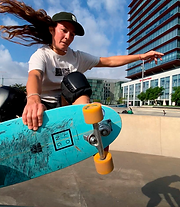Surfskate levels & experience
Have you ever wonder what is your riding level?
We believe that all sports, and especially board sports, are a resource for continuous improvement, not for comparing oneself with others. However, based on our teaching experience, we believe it's important to make distinctions from a pedagogical perspective. The reason we use this classification is because there are different levels of body and board control, which we must consider to avoid difficulties in learning, causing accidents, or frustrating the learner.
In this classification, we provide a brief description to define the levels we use and the exercises we teach. These descriptions are flexible and depend on the learning pace and effort. Whatever your level, we encourage you to prevent skipping levels and engage with the right learning process. This way, you will have a progressive evolution and avoid making future mistakes.
This content is part of the upcoming book that Manu and Mora are writing together. Want to know more? Subscribe to our newsletter.

Beginner
From zero. Usually, no previous experience on boards, or if they have, it is not able to stand in the surfskate. No autonomy at all.
An introductory course is a recommended starting point.
-
Familiarisation with the board
-
Recognise the stance and body movements
-
Balance exercises
-
Kicking
-
Pumping
-
Turning over flat ground

Amateur
It has autonomy, and knows how to generate speed, move and turn. Usually, movements are sketchy and unstable because of a lack of technique.
Review the basic technique and improve body control.
-
Control of the pumping sides
-
Toes and Heels turns
-
Turns with a grab
-
Slides
-
Weight and speed exercises

Low-Intermediate
An intermediate level implies good control of the board and the ability to generate and keep your speed. Being able to ride on flat ground with confidence is a must. At this point, you might have some experience in verticals but not much control. Probably you know how to perform some tricks.
Similar exercises, but taking them into verticals. A slope is ideal to learn progressively.
You should focus on speed control and right turning with your body parts. Some skate tricks can be included.
-
Snaps on a flat ground
-
Downhill
-
Pivoting
-
Drop In
-
Fakie

High-Intermediate
You have more control over verticals and slopes. Execute proper technical gestures. Nevertheless, a lack of a particular technique makes them stuck at an intermediate level. Many self-learners reach this point, but progressive learners also need guidance to unlock the next level.
Exercises that imply higher risk, such as height, speed, etc. Special focus on parts movements and weight balance. Embracing the basics to develop their personal style.
-
Cutback
-
360
-
Reverse
-
Layback
-
Snaps in verticals

Advanced
An advanced level is expected to be in control of every part of the body, executing fast and explosive rotations, managing to perform tricks and adapting to different surfaces with ease.
At this point, continuous technical exercises are recommended. Usually, exercises are meant to unlock specific tricks or common barriers acquired during the learning process.
-
Kickturn
-
50/50
-
Flyout
-
Indy/melon Grab
-
Snaps with cupping or different-shaped surfaces.